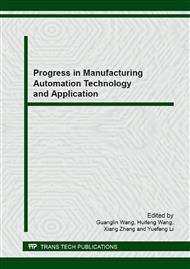p.761
p.765
p.770
p.775
p.781
p.787
p.792
p.798
p.804
The Design and Simulation of the Magnetic Field Formation Components Based on the Technology of Electro Permanent Magnet
Abstract:
As a typical kind of surface finishing technology, magnetic abrasive finishing has unique advantages in finishing effect, efficiency and application, it occupies a very important position and has huge potential application value. As the core component of the magnetic abrasive finishing, the magnetic field formation components have a direct impact on the finishing effect and efficiency. Electro permanent magnetic field formation components used in magnetic abrasive finishing are put forward based on the characteristics of electro permanent magnet and its application in crane and clutch. Analyzing the main performance and characteristics of the magnetic filed formation components and determining the overall scheme according to the total requirements of magnetic filed formation components. Analyzing the feasibility of the electro permanent magnetic filed formation components through the simulation and then forming the design method to further promote the industrialization process of magnetic abrasive finishing.
Info:
Periodical:
Pages:
781-786
Citation:
Online since:
September 2013
Authors:
Price:
Сopyright:
© 2014 Trans Tech Publications Ltd. All Rights Reserved
Share:
Citation:


